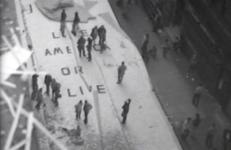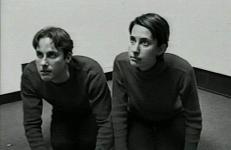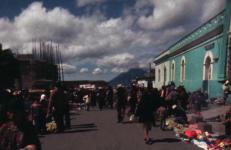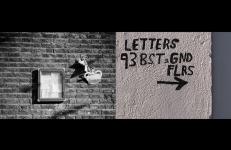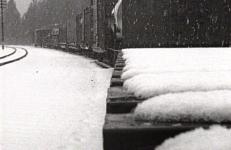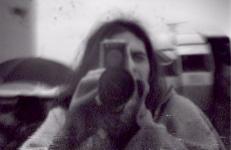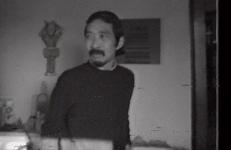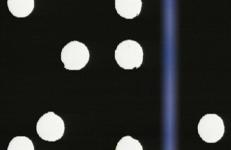The Videofreex document a street intervention by Turkish artist Tosun Bayrak (b.1926). The performance was to become a notorious example of the element of "shock" in contemporary art. Within the work:
Art History
tryphon: three sounds is a candid portrait of the artist Thomas H. Kapsalis (b.
One of several videos the artist made with her brother while still in graduate school at the University of Illinois at Chicago. Two Dogs and a Ball is a cover of William Wegman’s piece of the same title from the late 60’s. During the critique for this piece the artist, Jeff Wall, remarked that at this point anything can be art. This video revels in a degree of quality loss, and in this case it is brought it closer to the chopped and fuzzy original.
A cross-generational binding of three filmmakers seeking alternative possibilities to the power structures they are inherently part of. Each woman extends her reach to a subject she is outside of. Vever grew out of the abandoned film projects of Maya Deren and Barbara Hammer. Shot at the furthest point of a motorcycle trip Hammer took to Guatemala in 1975, and laced through with Deren’s reflections of failure, encounter and initiation in 1950s Haiti.
A vever is a symbolic drawing used in Haitian Voodoo to invoke Loa, or god.
A Walk with Nigel is a video essay that constructs a dialogue between two artists from two different times, between movement and stillness, between speech and silence. An archaeological study of a community, reawakening the archive in the present. A materialist study of streets and social relations.
The secret history of hobo and railworker graffiti. Shot on freight trips across the western US over a period of 16 years, Who is Bozo Texino? chronicles the search for the source of a ubiquitous rail graffiti--a simple sketch of a character with an infinity-shaped hat and the scrawled moniker, "Bozo Texino"--a drawing seen on railcars for over 80 years.
Ming Wong creates videos that explore performance and issues of race and gender. Born in Singapore of Chinese heritage, and now based in Berlin, his work examines cross-cultural experiences by appropriating scenes of iconic world cinema. Wong casts himself anachronistically as the star, critically exposing the otherness of the relationship of media and world history.
Videofreex documentation from October 9th, 1971 of a crowd celebrating the opening of the Yoko Ono retrospective exhibition, This Is Not Here, at the Everson Musem of Art in Syracuse, NY. The Videofreex document Yoko Ono’s plane landing and her getting on a bus to go to the exhibition at the Everson Museum. Once at the exhibition, we find a man inside bathing in a bathtub, who is then forced to exit by a museum official.
As a well-known painter and collagist, teacher at the School of the Art Institute of Chicago and mentor to the Chicago Imagists, Ray Yoshida (1930-2009) had far reaching influence. In this interview, Yoshida offers a tour of his home, showing us the unique dolls, masks, trinkets and tattoo art from which he drew inspiration. Describing his own stylistic progression from the late 1950s to the early 1970s, Yoshida also talks about the collage aesthetic and persistence of visual complication in the Chicago Imagist style, demonstrating its various permutations by showing off his collection of works by former students at SAIC. A lover of curiosities, Yoshida also describes discussions he had with Chicago artist Roger Brown about opening a museum for their vast collections of oddities.
— Kyle Riley
A piece of movie film has survived the forthcoming Ice Age and is discovered by Venusian scientists--5000 years from now... This work is a correspondence of two information fragments of different origins and times that met by accident. Cinema transforms into a three-dimensional landscape--utilizing data that is based on an archaeological misinterpretation. Zuse Strip is named after Konrad Zuse’s first digital computer. It used discarded 35mm movie film from the German UFA as a medium to read and write 8-bit binary code data with a hole-punch system.




